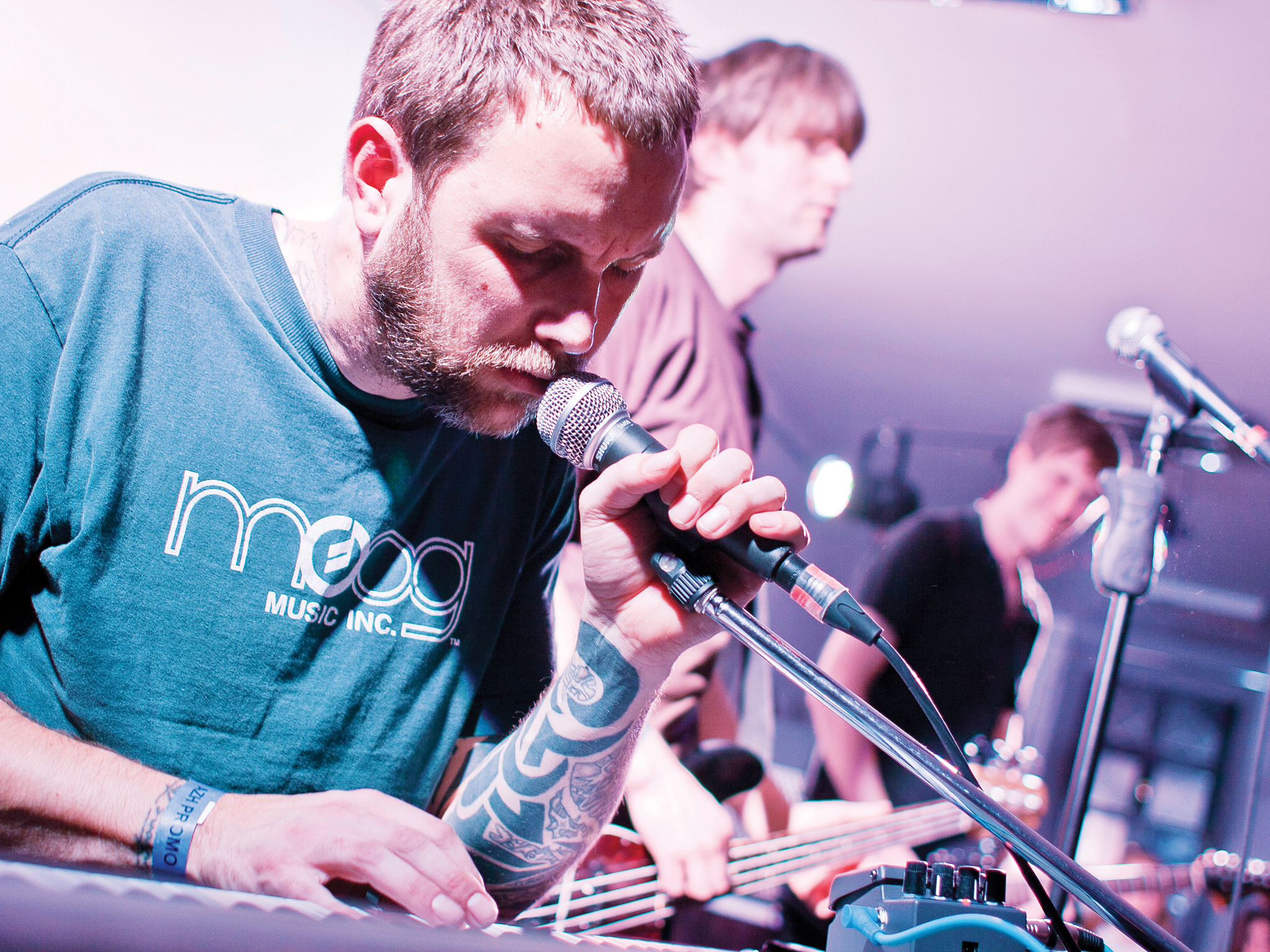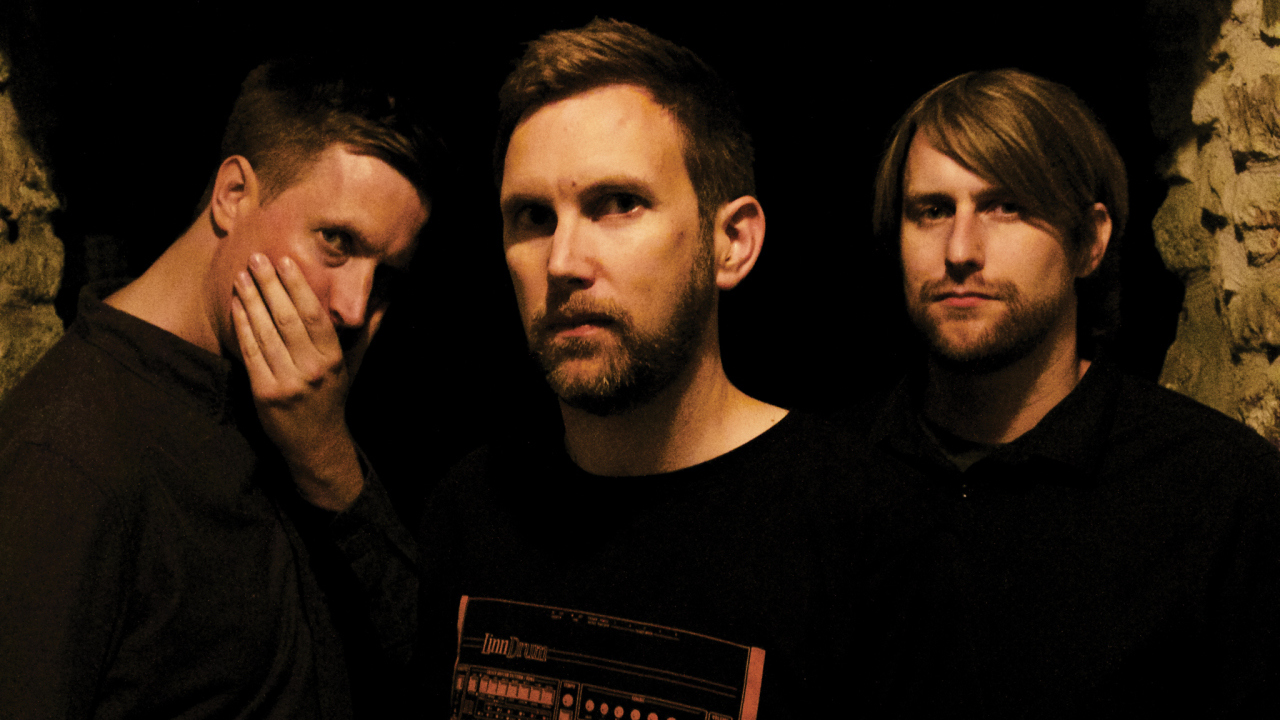The underground scene isn’t a bad place. Desirable qualities such as mystique and invention thrive there, while niche but immensely loyal followings are developed because of it.
Nevertheless, the underground’s truly valuable time often has a shelf life, before the natural urge to go, well, above ground takes hold. Or at least the urge to give it a bloody good try.
Which is the situation in which Blueneck find themselves. Venerable veterans of the underground progressive scene, the West Country outfit are raising their heads above ‘specialist’ waters and into the light of the big game. After four critically praised albums, their fifth, King Nine – a beautifully commanding, haunting work of progressive post-rock – comes backed by an elevated business element. After years of relative modesty and almost defiantly DIY-ish values, the Blueneck operation has stepped up a gear.
“I think it’s because Duncan’s mum told us she couldn’t do our admin any more,” guitarist Richard Sadler deadpans down the phone, in very deep Queen’s English. “But no, we didn’t want to compromise on this one. Whether that be in the way it was recorded, the way it was written, the money we’ve put into it, the promotion…”
Over three years in the making, King Nine might be infused with ambiguity, but there’s something quietly urgent about it. Melodies and guitar parts shine with new confidence, electronica elements hit Boards Of Canada-esque sophistication, and soft layers of strings and brass give the sense of something altogether more regal; something on a welcoming but grander scale.
“I think the new album as a whole is more accessible than our previous ones,” vocalist/instrumentalist/composer Duncan Attwood says.
Compared with Sadler’s velvet-voiced, instantly easy demeanour, the Somerset-based (and very Somerset-sounding) founder of Blueneck is a friendly if slightly anxious character. As a singer, he’s both other-worldly and strangely intimate, uniting the electronic and organic elements of his band (completed by Ben Paget) in one Kid A-era Radiohead cocktail.
“It’s more immediate,” he continues. “So it made sense to try and get more people to listen to it, and the only way you’re going to do that is to try and get it out there a bit more.”
So far this has involved a distinctly more official, slick press campaign, complementing the extra edge of confidence in the music itself.
Even the packaging makes a bolder statement. While the artwork of previous albums had followed a graphic design-driven approach, King Nine employed the photographic skills of Lasse Hoile – Danish artist and darling of the experimental music world, lately thanks to his film and stills work for Steven Wilson.
“I explained to him that we wanted deserted, desolate images that still had some sort of life in them. Or a hint that there was once life in them, not long ago,” Attwood explains. “Rather than just a ‘dead image’.”
The filmic quality of Blueneck has steadily grown over the years, and it peaks in the orchestral, storytelling scope of King Nine. Putting such tendencies into more direct practice, Attwood soundtracked a short film pilot for Cult Of Luna frontman Johannes Persson – a Swedish “apocalyptic zombie” oeuvre.
“It was actually really good,” Attwood says brightly. “Not in the same vein as most zombie movies – it was more understated.”
Elsewhere on the filmic scale, the band draw from an intriguing blend of Ennio Morricone soundtracks, and sci-fi flicks of the late 70s and early 80s. The creepy electronics of John Carpenter, for instance, translate oddly well into Blueneck’s enigmatic, 21st-century formula.
“If you listen to something like Father, Sister, there’s definitely a big nod to [Carpenter-soundtracked movie] Assault On Precinct 13. We love it,” Sadler enthuses. “And if you look at Lasse’s artwork, we felt we needed those cinematic widescreen shots, whereas before we’d taken a more graphic design-driven approach.”
Such evocative visual connotations and heightened instrumentals are profoundly uplifting in the likes of gorgeous opener Counting Out – without sacrificing their dark and ethereal qualities. Lyrically, however, it’s weepingly sad, hitting you like a sudden lump in the throat with plaintive, poetic notions of death and isolation. While Attwood admits that death and isolation are indeed key themes, drawing from personal experience, he’s keeping the exact details to himself.
“Some people go through grieving processes and find it very hard to cope with,” Attwood says. “I was lucky enough to have an album to write and use as an outlet. I can’t say how therapeutic it was, and I’m very proud of it and feel very good about it. But I think it’s the right decision to not say what it’s about. It’d just give the album too much of a dominantly dark thing.”
“Counting Out is one of my favourite Blueneck songs because it does evoke that kind of upbeat sense of hope, even though I know what it’s about,” Sadler says. “And we love that disparity between two emotions.”
Realising the Blueneck sound (with its myriad instrumentals and layers of programming) in a live setting is no picnic – especially not for an act operating on a shoestring. Accordingly, they’ve evolved into an increasingly studio-focused band, with no current plans to tour King Nine.
“We’ve agreed we’ll only take this live if we think we can do it justice,” Attwood says firmly.
“Its a bit of a double-edged sword really,” Sadler concedes. “I mean, we’ve had some fantastic experiences on tour. We’re not playing enormous venues, but we’ve played in some amazing cities and places, met some lovely people and had some of the best experiences of my life.”
Fond memories grew from small but beautiful gig settings in Athens, across Germany and various other European destinations.
“The first time we played in Dresden, there were loads of people in suits and dresses in the crowd,” Sadler remembers. “We wondered what was going on, and then this guy in a two-piece suit says, ‘Oh, we just had our wedding today, and we based our reception around knowing you guys were going to be here.’ We couldn’t believe it. I mean, that’s either insane or very beautiful!”
One might have imagined a similar beauty at their Glastonbury set this year. Late at night, in the Avalon field, on paper it sounds like an idyllic way to conquer Britain’s biggest festival. On paper…
“Yeah, don’t do that is my advice,” Sadler says at once. “Don’t play at midnight, after Kasabian, en route to Lost Vagueness, because your crowd tend to be the pilled-up Kasabian crowd. Your front row has pupils the size of Terry’s Chocolate Oranges.”
“There was a couple of people on each others’ shoulders, which you wouldn’t expect to see at a Blueneck gig…” Attwood remembers. “And then someone was playing a blow-up guitar, that was quite odd. But to be fair, there were quite a few people just quietly listening. I think we had a few hundred people in the tent, and afterwards my wife told me that there was probably about 200 people sat outside, enjoying it.”

Still, in the cold light of day, eight years of painstaking album craft – alongside day jobs – in relative obscurity takes its toll.
“I did go in with the attitude that this could be our last album,” Attwood concedes. “Y’know, it’s taken nearly four years to get this one down. I wanted to make sure the end product was something I was completely pleased with… I’m very aware that because it is quite different from the post-rock sound we’ve done before, it could completely flop. But it’s important that if it does, I’d still be happy with it.”
Given that the pair have been working remotely for the last three or so years – making ever greater use of different technologies – it seems likely that any future Blueneck records could expand on their maturing electronic side.
“It certainly could be the last album in this form,” Sadler agrees. “We both absolutely love Boards Of Canada. The next project could easily be something like that, or it could be an instrumental track, it could be a Tex Mex country and western…”
“Me and Rich do have a secret love for country, and certainly alt-country,” Attwood adds. “So we will at some point do an alt-country album.”
“Yeah, there will be an electronica album, and_ then_ there will be an alt-country record!” Sadler affirms.
“We need to make a record whereby me and Rich can just go on our own and tour across America,” Attwood laughs. “It’s a romantic image I have of us going off into the sunset together. A lovely bromance.”
A chatty hour or so later, they hang up and disappear into the night, back to their respective families. Sadler lives in London with his fiancée while Attwood has three children, downtime happiness pegged on the success of Liverpool FC. “So I’m pretty miserable at the moment!” he laughs. “I was very happy last season, hence why King Nine has that happier feel to it.”
Whatever becomes of King Nine, its assured voice and lavish framework at least sound like a band in a higher league. A majestic manifestation of brooding, introverted material. Maybe even the last, from these kings of the progressive underground. Here’s hoping it’s just the last in this particular chapter…
_King Nine is out now on Denovali. See http://www.facebook.com/BlueneckUK for info. _
The birth and rise of Blueneck
Wondering where exactly these guys came from? Fear not, their beneath-the-surface presence has kept them in a decidedly ‘obscure’ camp. Until now, hopefully…
The roots of Blueneck go back to 2006, when Duncan Attwood assembled a small group of friends to record debut LP Scars Of The Midwest. Drawing from the likes of Godspeed You! Black Emperor, it had an atmospheric, melancholic but harrowing feel, both experimental and tension building. Come 2010, The Fallen Host – also melancholic but with added aggression – reaped their first seriously glittering reviews. Like Scars… it was recorded in rural Somerset. Words like “stunning” became popular, and were sustained for incredible third album Repetitions in 2011, which saw the band up sticks to producer Mat Sampson’s studio in Bristol (by now, Sadler had also joined the fold). Here we saw the kind of real emotional power and melodic conviction Blueneck are capable of. Something bigger was coming to life. And as if paving the way for the cinematic scale of King Nine – also produced by Sampson (“His role shouldn’t be underestimated,” Attwood says) – 2012 instrumental LP Epilogue begun concurrently with it. It quickly became clear that King Nine – released on Denovali Records – was going to be something of a magnum opus.
“I started writing both at the same time,” Attwood explains. “I went into the studio in 2011 and formed the basis of some of the King Nine tracks, but me and Rich knew it was going to be two separate albums. Epilogue was a lot easier to do, and even in those early days we had quite big plans for King Nine. We knew it would take a lot longer… Spiderlegs [King Nine track] is actually an expansion on the final track on Epilogue,” Sadler says. “It’s kinda like the bigger brother.”

